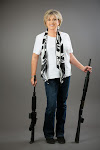 The girls and I had a recent photo shoot with local photographer Alexa Gintoff. Here is one of my favorite pictures. We will be sharing more photos in upcoming newsletters. Enjoy!
The girls and I had a recent photo shoot with local photographer Alexa Gintoff. Here is one of my favorite pictures. We will be sharing more photos in upcoming newsletters. Enjoy!Exciting News...
Utah only CCW class on Thursday July 2nd.
For those of you who are interested in obtaining a Concealed Carry Permit from Utah I will be offering the 4 hour course on Thursday July 2nd. We will begin at 8am and be finished by noon. There is no firearm qualification required, therefore no need to bring your gun or any ammo. to class.
For those of you who already have your Nevada CCW, by adding Utah it allows you to carry in quite a few more states than your Nevada alone. If you are a Nevada resident and plan on carrying concealed you MUST obtain your Nevada CCW.
This is a great course for all of you Nevada non-residents as well.
For more information don’t hesitate to contact me. Class size is limited so sign up ASAP.
Below is a list of reciprocity sates that honor the different permits:
Nevada AK*, AR, AZ, FL, ID, IN, KS, KY, LA, MI, MN, MO, MT, OK, SD, TN, TX, UT, VT*,
Utah AK*, AL, AR, AZ, CO, DE, FL, GA, ID, IN, KY, LA, MI, MN, MO, MS, MT, NC, ND, NH, NM, NV, OH, OK, PA, SD, TN, TX, VA,
VT*, WA, WV, WY,
Illinois (IL) and Wisconsin (WI) are "Non CCW issue states".**Colorado (CO), Michigan (MI), South Carolina (SC), New Hampshire (NH), Florida (FL), Kansas (KS) and West Virginia (WV) only honor permits from residents of the issuing states. (* Vermont (VT) & Alaska (AK). Anyone who can legally own a firearm can carry it concealed. No Permit/license is required.)
States in red issue Non-Resident Permits. Indiana (IN), Iowa (IA), Maryland (MD),
New Jersey (NJ), Oregon (OR) and Tennessee (TN) have a very restrictive Non-Resident issue policies.
A special message from Kristy.
Summer time is finally here! The snow has melted, the flowers are blooming, neighborhood parks are packed and the aroma of a backyard BBQ is filling the air. It is time for us to dust off the camping gear, get the bikes out, head to the beach, or for many of you- it’s time to head to the shooting range!
This weather beckons us to spend more time outside: gardening, walking, biking, and sitting on our porches enjoying the summer evening. While sleeping, it is not uncommon for many to open up their windows and sliding glass doors to let the cool night breeze flow through their homes. Keep in mind, many of these activities lead to a greater chance of becoming a victim of a crime. I cannot stress enough how important it is to be aware of your environment and pay attention to your surroundings! No matter how familiar we are with our homes, our work, or the grocery store we frequent the most; we must never be complacent about our surroundings. Analyze the people around you, examine the shrubbery, dark corners, and parked cars. Small simple steps such as these can help us avoid potential victimization.
Being aware is just one small segment of the whole picture of personal security! If you haven’t already, explore and review your options for a self-defense weapon. The spectrum is wide and there is something for everyone: from pocket sized mace to a reliable and easy-to-conceal firearm.
Whatever your favorite summer hobbies are, it is important to keep your personal safety at the forefront of your daily activities; both at home or on-the-go! For more personal protection ideas and strategies that you can implement into your daily life; please join The Women’s Shooting Academy for our first Refuse to Be a Victim seminar June 13th.
Kristy-
Do you know how to treat a Bullet Wound?
Gunshot wounds are one of the most serious forms of trauma that you can encounter. Gunshots cause three types of trauma: penetration (destruction of flesh by the projective), cavitation (damage from the bullet's shock wave in the body), and fragmentation (caused by pieces of the projectile or bone). It is very difficult to predict the degree of damage done by a gunshot wound, and many of the injuries caused by a gun far exceed what you can reasonably treat. For this reason, the best option for most gunshot wounds is to get the victim to a hospital as soon as possible. Read on to learn what you can do to help stabilize a gunshot victim.
Make sure you are safe.
Call for help.
Do not move the victim unless you must do so to keep him safe, or to access care i.e.: in a rural or off-road setting.
General principles of first aid for bullet wounds.
Steps, warnings and tips are only for your consideration. Although the specifics of treating a gunshot wound will vary somewhat depending upon the part of the body where it occurs, these steps can be applied to all gunshot wounds.
Act quickly.
Check the A, B, C, D, E's.
A (Airway)
B (Breathing)
C (Circulation)
D (Disability)
E (Exposure)
Control bleeding.
Be prepared to treat the victim for shock.
Wait for help to arrive.
Special instructions for regions of the body.
* Head – Gunshot wounds to the head are frequently fatal. Your best option is to keep the head elevated and get the victim to a trauma center as soon as possible.
* Face and neck – These wounds typically bleed severely. Use direct pressure to control bleeding and keep the victim upright. Be careful not to obstruct breathing while controlling bleeding. With injuries to the neck, be careful that blood flow to the carotid arteries isn't disrupted, as this can reduce blood flow to the brain.
* Chest and back – Apply direct pressure to control bleeding; understand that it may be difficult to control chest bleeding because the ribs make it difficult to compress the structures that are bleeding. Gunshots to the chest can cause what is known as a "sucking chest wound". These happen when air travels in and out of the wound with each breath. Treat these as follows:
* Seal wound with hand or airtight material (e.g., plastic film).
* Apply an airtight bandage on three sides of the wound. Do not close the bandage on the fourth side.
* Lift the unsealed side of the bandage as the victim exhales to allow air to escape.
*Abdomen – Use direct pressure to the injury site. As with the chest, controlling bleeding in these cases can be quite difficult.
*Arm or leg – Use direct pressure to control bleeding. Arm and leg injuries from gunshots can be elevated above the heart to help control bleeding. Use pressure points in the arm, groin, or behind the knee if direct pressure does not control bleeding.
* Never use a tourniquet except to:
Save a life when excessive bleeding can not be stopped by pressure or to go to get help when alone.
If you must use a tourniquet, then to arm or leg only and above bleeding (never on any other part of the body.)!
* Never use wire, string or similar narrow material that could cause a new cut or bursting injury or additional bleeding when tightened.
You can now find many of The Women’s Shooting Academy classes being taught at Scheels. We are very excited they have embraced our classes and support our mission to educate
ALL women in the Reno/Sparks area.
For a list of class schedules please visit our website.
ALL women in the Reno/Sparks area.
For a list of class schedules please visit our website.
Coming next month....A special message from Hanae!
Let your gun therefore be the
constant companion of your walks-
Thomas Jefferson
There is still availability for the June 13th Refuse to be
a Victim Seminar. This seminar will be held at Cabela's.
Call today to reserve your seat!
Let your gun therefore be the
constant companion of your walks-
Thomas Jefferson
There is still availability for the June 13th Refuse to be
a Victim Seminar. This seminar will be held at Cabela's.
Call today to reserve your seat!
EDUCATE - ENCOURAGE - EMPOWER
Until next time....
Vicki~
Until next time....
Vicki~




